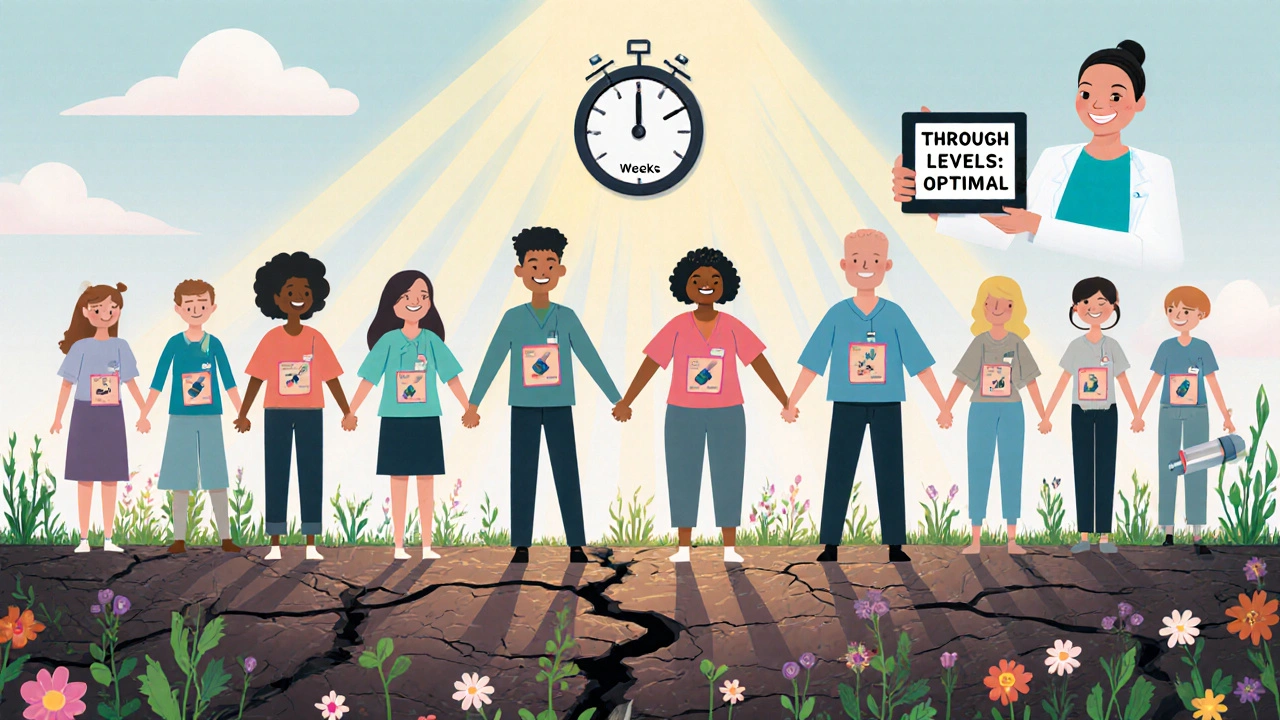For someone living with Crohn’s disease, every day can feel like a gamble. One day you’re fine, the next you’re in pain, rushing to the bathroom, or stuck in bed from fatigue. It’s not just diarrhea or cramps-it’s a chronic, unpredictable inflammation tearing through your gut, sometimes for years, with no clear end in sight. But the landscape of treatment has changed dramatically since the late 1990s. Today, biologic therapy isn’t just an option-it’s often the turning point that lets people regain control of their lives.
What Exactly Is Crohn’s Disease?
Crohn’s disease is more than just an upset stomach. It’s a type of inflammatory bowel disease (IBD) where the immune system attacks the digestive tract, causing long-lasting inflammation. Unlike ulcerative colitis, which only affects the colon, Crohn’s can hit anywhere from your mouth to your anus. Most often, it targets the end of the small intestine (terminal ileum) and the beginning of the colon. About 70-80% of cases show up there. The inflammation isn’t just on the surface-it goes deep into the intestinal wall. This leads to complications like strictures (narrowing), fistulas (abnormal tunnels between organs), and abscesses. Up to 50% of people develop strictures within 10 years of diagnosis. Around 30% get fistulas. These aren’t just uncomfortable-they can require surgery. What triggers this? It’s not one thing. Genetics play a big role. If you have a close relative with Crohn’s, your risk goes up. Mutations in the NOD2 gene are found in 30-40% of people with familial cases. But genes alone don’t cause it. Environmental factors like smoking, diet, antibiotics in childhood, and even where you live (higher rates in cities and northern climates) contribute. Your gut bacteria also get involved. In Crohn’s, the immune system overreacts to harmless microbes, turning a normal defense into a constant war.How Inflammation Turns Into a Vicious Cycle
Inside the gut of someone with Crohn’s, immune cells like T-cells and monocytes swarm the lining. They release powerful chemicals-TNF-alpha, IL-12, IL-23-that keep the inflammation going. These aren’t just random signals. They’re like alarm bells that never turn off. The immune system keeps sending more cells in, even when there’s no real threat. One key player is the α4β7 integrin, a molecule that acts like a homing device for immune cells, pulling them straight into the gut. That’s why some newer biologics target this pathway specifically. The result? Thickened intestinal walls, ulcers, and eventually, scarring. This isn’t just damage-it’s a self-sustaining loop. The more inflammation, the more damage; the more damage, the more inflammation.Biologic Therapy: Targeting the Root Cause
Before biologics, treatment was mostly about putting out fires: steroids to calm inflammation, immunomodulators like azathioprine to suppress the immune system, and antibiotics for infections. These helped some, but they didn’t stop the disease from progressing. And long-term steroid use? It brings its own problems-bone loss, weight gain, diabetes, mood swings. Biologics changed that. These are lab-made proteins designed to block specific parts of the immune response. Think of them as precision tools instead of sledgehammers. Anti-TNF drugs were the first wave. Infliximab (Remicade), adalimumab (Humira), and certolizumab pegol (Cimzia) block TNF-alpha, one of the main drivers of inflammation. Studies show they induce remission in 30-40% of patients-nearly double the rate of placebo. They also help heal the gut lining, something older drugs rarely did. Vedolizumab (Entyvio) works differently. Instead of hitting TNF, it blocks the α4β7 integrin, stopping immune cells from even reaching the gut. This makes it more targeted. It’s less likely to cause systemic infections because it doesn’t affect the rest of the immune system. But it takes longer to work-10 to 14 weeks compared to 2 to 4 for anti-TNF drugs. Ustekinumab (Stelara) goes after IL-12 and IL-23, two cytokines that fuel T-cell activity. In clinical trials, about 34-44% of patients reached remission within 8 weeks. At one year, half of them were still doing well. That’s a big deal for people who don’t respond to anti-TNF drugs.Which Biologic Is Right for You?
There’s no one-size-fits-all. Choosing depends on your disease pattern, risk factors, and lifestyle.- If you have severe inflammation, strictures, or fistulas, anti-TNF drugs are usually first. They work fast and have the most real-world data.
- If you’ve had multiple infections, or you’re at risk for multiple sclerosis, vedolizumab might be safer because it’s gut-specific.
- If you’ve tried an anti-TNF and it stopped working, ustekinumab is a solid next step.

Real Stories, Real Outcomes
Online communities like Reddit’s r/Crohns_Disease are full of stories that numbers can’t capture. One user, ‘CrohnWarrior87,’ went from 15 bowel movements a day to just 2 after three infliximab infusions. He’d tried three other treatments that failed. Another, ‘IBDSurvivor22,’ developed a lupus-like reaction on Humira after 18 months. He needed six months of steroids to recover. A 2023 survey of over 1,200 patients found 78% felt their quality of life improved on biologics. Hospital visits dropped by 72%. Most stopped relying on steroids. But 65% said cost was a barrier. 40% skipped doses because they couldn’t afford them. Side effects are real. About 12-15 out of every 100 patients on biologics get serious infections-like tuberculosis or pneumonia. That’s why everyone gets screened before starting. TB tests, hepatitis panels, heart checks-they’re not red tape. They’re life-saving.Therapeutic Drug Monitoring: Dosing That Works
One of the biggest mistakes? Giving the same dose to everyone. Biologics don’t work the same in every body. Some people clear them too fast. Others make antibodies that neutralize them. That’s why therapeutic drug monitoring is now standard. Doctors check blood levels of the drug-trough levels-to see if you’re getting enough. For infliximab, the sweet spot is 3-7 μg/mL. For adalimumab, it’s 5-12 μg/mL. Patients who maintain these levels are 3.5 times more likely to stay in remission. If levels are low, the dose can be increased. If antibodies are present, switching drugs or adding an immunomodulator like azathioprine can help. This isn’t guesswork. It’s science.What’s Next? Emerging Treatments
The future is coming fast. Ozanimod, a pill that traps immune cells in lymph nodes, showed 37% remission in trials. Mirikizumab, which blocks just IL-23 (not IL-12), had 40% of patients showing major gut healing. Both are in late-stage trials. Biosimilars-cheaper copies of biologics like infliximab-are already here. They work the same way but cost 15-30% less. In the next five years, they could make treatment more accessible.
Living With Biologic Therapy
Managing Crohn’s isn’t just about taking a drug. It’s about building a system. You need:- An IBD nurse specialist-available at 92% of major centers-to help with injections, side effects, and questions.
- A support network. About 25-30% of patients feel anxiety around infusions or injections. Cognitive behavioral therapy helps.
- Apps like MyIBDCoach to track symptoms, medications, and bowel habits.
- Patient assistance programs. Some cover 30-50% of out-of-pocket costs if you qualify.
When to Start Biologics?
The old approach was step-up: start with mild meds, then escalate if things got worse. That’s outdated. Experts now recommend a top-down strategy for those with poor prognostic signs-deep ulcers, fistulas, perianal disease, or early need for steroids. Waiting until you’re in crisis means more damage. And damage doesn’t reverse easily. Starting biologics early doesn’t mean you’re on them forever. But it gives you the best shot at long-term remission.Final Thoughts
Crohn’s disease is still not curable. But it’s no longer a life sentence of pain and uncertainty. Biologic therapy has turned a once-debilitating condition into a manageable one-for many. It’s not easy. There are costs, side effects, and logistics. But for thousands, it’s the reason they’re back at work, traveling, playing with their kids, or just living without constant fear. The key? Don’t wait. Talk to your doctor early. Get tested. Understand your options. And don’t let cost or fear stop you from asking for what you need. You deserve to feel better.Can biologic therapy cure Crohn’s disease?
No, biologic therapy cannot cure Crohn’s disease. It doesn’t eliminate the underlying genetic or immune triggers. But it can induce deep remission-meaning no symptoms, no inflammation visible on scans, and no need for steroids. Many people stay in remission for years, especially when treatment is started early and monitored closely.
How long does it take for biologics to work?
It varies by drug. Anti-TNF agents like infliximab and adalimumab often start working in 2 to 4 weeks, with full effect by 12 weeks. Vedolizumab takes longer-typically 10 to 14 weeks before you notice improvement. Ustekinumab can show results in 8 weeks. Patience is key, but if there’s no change after 12-16 weeks, your doctor may adjust your treatment.
Do biologics increase the risk of cancer?
There’s a small increased risk of certain skin cancers and lymphoma, but the absolute risk remains low. Studies show the risk is higher in people who’ve been on immunosuppressants for years or who smoke. Regular skin checks and avoiding sun exposure help. The bigger concern is serious infections-not cancer. Your doctor will screen you for hepatitis, TB, and other infections before starting.
Can I stop biologics if I feel better?
Stopping biologics is risky. Even if you feel fine, inflammation may still be active under the surface. Stopping often leads to flare-ups-and sometimes, the drug won’t work as well if you restart. Some people do successfully taper off under close supervision, but this is rare and only done after years of stable remission and normal scans. Never stop on your own.
Are biosimilars as good as the original biologics?
Yes. Biosimilars like Inflectra (a biosimilar to infliximab) are rigorously tested to be nearly identical in structure, safety, and effectiveness. The FDA approves them only after proving they work the same way in the body. Many patients switch without issue. The main difference is cost-biosimilars can be 15-30% cheaper, making treatment more accessible.
What if my insurance denies my biologic?
Insurance denials are common. Your doctor can file an appeal with clinical evidence-like endoscopy results or failed prior treatments. Many drugmakers offer patient assistance programs that cover copays or even provide free medication for those who qualify. IBD nurse specialists can help you navigate this. Don’t give up-many approvals are granted on appeal.
Can I get vaccinated while on biologics?
Yes, but timing matters. You should get all routine vaccines-flu, pneumonia, shingles, COVID-19-before starting biologics if possible. Once you’re on them, avoid live vaccines like MMR or yellow fever. Inactivated vaccines are safe. Always check with your IBD team before getting any shot. Vaccines are especially important because biologics increase infection risk.


Michael Segbawu
November 29, 2025 AT 00:22they dont cure anything just keep you alive long enough to pay more
my uncle died waiting for insurance to approve his humira
Aarti Ray
November 29, 2025 AT 17:53my sister took ustekinumab for 6 months and her pain went away but we had to sell her gold necklace to pay for it
no one talks about this part
Alexander Rolsen
November 30, 2025 AT 19:39Leah Doyle
December 1, 2025 AT 11:13i haven't had a flare in 4 months
thank you to everyone who shared their stories here, i didn't think it was possible to feel normal again :)
Alexis Mendoza
December 3, 2025 AT 07:52but what if the problem isn't the parts but the way we're living
maybe we're just too clean, too processed, too disconnected from the earth
biologics help but they don't ask why this is happening to so many of us
Michelle N Allen
December 5, 2025 AT 06:45so many words for something that still doesn't fix anything
you take a shot every two weeks and hope you don't get cancer or a bad infection
and then you still have to deal with your life and your job and your family and your pain
it's just exhausting
Madison Malone
December 6, 2025 AT 22:08every time you feel like giving up, remember you're already stronger than you think
you're still here, still fighting, still trying
that matters more than any lab result or drug level
Chris Kahanic
December 8, 2025 AT 04:23Geethu E
December 9, 2025 AT 02:03it worked just as good as the original
and i saved enough to buy my daughter a new school bag
why are people still scared of them? they're not fake medicine
anant ram
December 10, 2025 AT 08:46king tekken 6
December 11, 2025 AT 07:53and the real cure is just eating raw garlic and walking barefoot on grass?
yeah right
next you'll say the moon landing was faked
DIVYA YADAV
December 13, 2025 AT 01:19biologics are just a cover for the government to track your gut bacteria through your blood
they already know what you eat, where you go, who you talk to
why do you think they push these injections so hard?
they're harvesting your microbiome data for the new world order
Kim Clapper
December 13, 2025 AT 16:40Bruce Hennen
December 14, 2025 AT 08:57